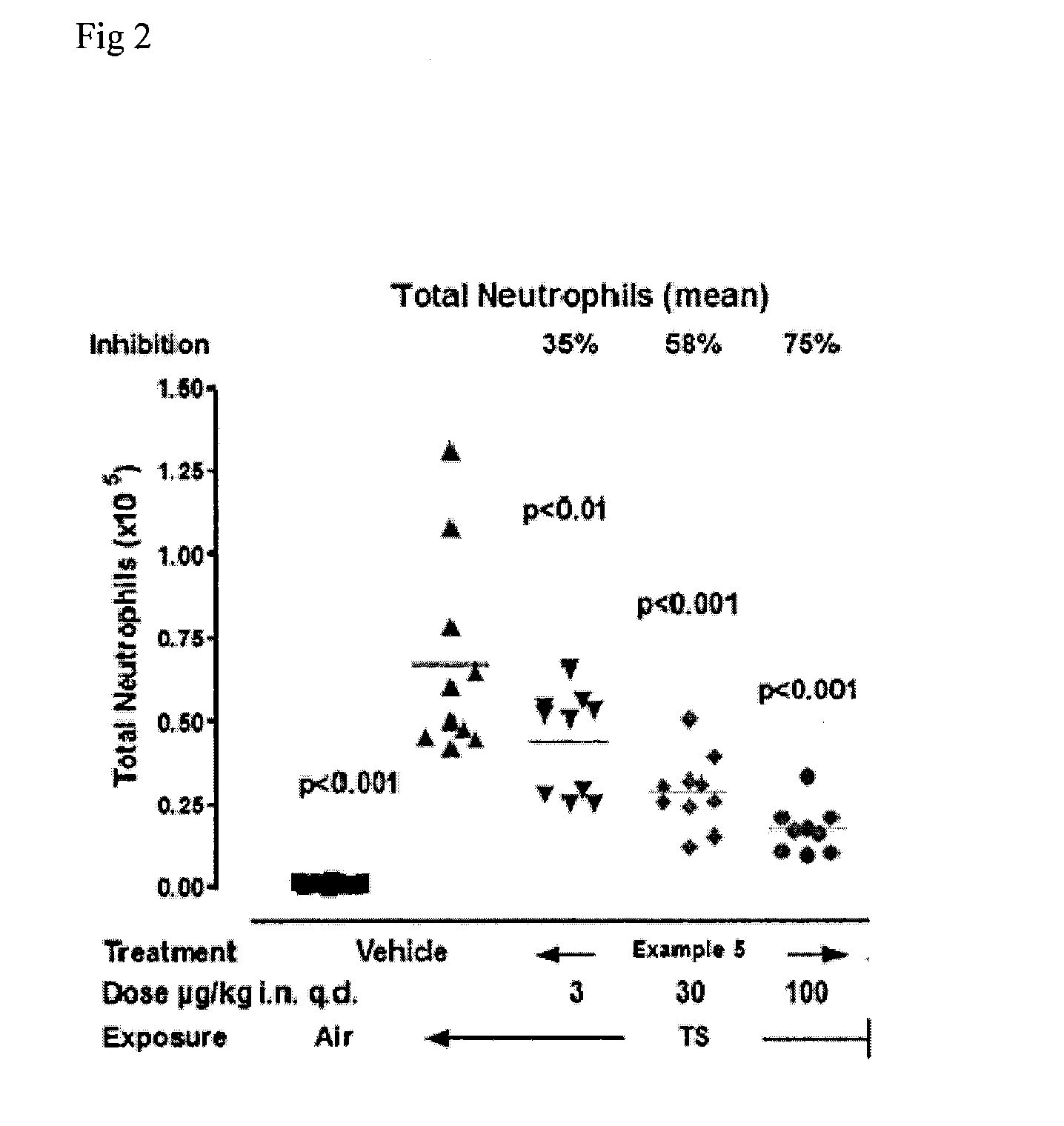Kinase inhibitors
a kinase inhibitor and inhibitor technology, applied in the field of kinase inhibitors, can solve problems such as inflammation within the lung environment, and achieve the effects of reducing side effects, reducing side effects, and reducing side effects
- Summary
- Abstract
- Description
- Claims
- Application Information
AI Technical Summary
Benefits of technology
Problems solved by technology
Method used
Image
Examples
example 1.1
Example 1. 1-(5-tert-Butyl-2-p-tolyl-2H-pyrazol-3-yl)-3-{(1S,4R)-4-[3-(2-pyrrolidin-1-yl-ethyl)-[1,2,4]triazolo[4,3-a]pyridin-6-yloxy]-1,2,3,4-tetrahydro-naphthalen-1-yl}-urea
[0551]
a. 3-Pyrrolidin-1-yl-propionic acid N′-(5-fluoro-pyridin-2-yl)-hydrazide (Intermediate 1a)
[0552]
[0553]5-fluoro-2-hydrazinopyridine (285 mg, 2.24 mmol) and 3-(pyrrolidin-1-yl)propanoic acid hydrochloride (400 mg, 2.24 mmol) were dissolved in DMF (15 mL). EDC (516 mg, 2.69 mmol), HOBt (30.0 mg, 0.22 mmol) and triethylamine (374 μL, 2.69 mmol) were added and the reaction stirred for 18 h. The mixture was loaded onto an SCX-2 cartridge, which was washed with MeOH then with 2M NH3 in MeOH. The basic fractions were evaporated in vacuo then purified by FCC using 0-10% [2M NH3 in MeOH] in DCM to give the title compound contaminated with several impurities (400 mg). The product was used in the next step without further purification.
b. 6-Fluoro-3-(2-pyrrolidin-1-yl-ethyl)-[1,2,4]triazolo[4,3-a]pyridine (Intermediat...
example 2.1
Example 2. 1-(5-tert-Butyl-2-p-tolyl-2H-pyrazol-3-yl)-34(1S,4R)-4-{3-[2-(4-methyl-piperazin-1-yl)-ethyl]-[1,2,4]triazolo[4,3-a]pyridin-6-yloxy}-1,2,3,4-tetrahydro-naphthalen-1-yl)-urea formate salt
[0559]
a. 3-(4-Methyl-piperazin-1-yl)-propionic acid N′-(5-fluoro-pyridin-2-yl)-hydrazide (Intermediate 2a)
[0560]
[0561]5-fluoro-2-hydrazinopyridine (295 mg, 2.32 mmol) and 3-(4-methyl-1-piperazinyl)propionic acid (400 mg, 2.32 mmol) were dissolved in DCM (15 mL). EDC (536 mg, 2.79 mmol) and HOBt (31.0 mg, 0.23 mmol) were added and the reaction stirred for 18 h. The mixture was loaded onto an SCX-2 cartridge, which was washed with MeOH product eluted with 2M NH3 in MeOH. Further purification by FCC, using 0-10% [2M NH3 in MeOH] in DCM, afforded the title compound (458 mg, 1.63 mmol, 73%). 1H NMR (400 MHz, CDCl3): 2.32 (3H, s), 2.48-2.54 (2H, t, J 6.0), 2.54-2.70 (8H, br s), 2.69-2.75 (2H, t, J 6.0), 6.60-6.65 (1H, dd, J 8.9, 3.3), 6.75-6.78 (1H, d, J 4.4), 7.25-7.34 (1H, m), 8.02-8.05 (1H, d...
example 3.1
Example 3. 1-(5-tert-Butyl-2-p-tolyl-2H-pyrazol-3-yl)-3-[(1S,4R)-4-(3-piperidin-1-yl)-[1,2,4]triazolo[4,3-a]pyridin-6-yloxy)-1,2,3,4-tetrahydro-naphthalen-1-yl]-urea
[0567]
a. Piperidine-1-carboxylic acid N′-(5-fluoro-pyridin-2-yl)-hydrazide (Intermediate 3a)
[0568]
[0569]1-Piperidine carbonyl chloride (348 mg, 0.30 mL, 2.36 mmol) was added dropwise to a solution of 5-fluoro-2-hydrazinyl-pyridine (see for reference WO 2010 / 022076, which is incorporated herein by reference in its entirety; 0.30 g, 2.36 mmol) and DIPEA (1.2 mL, 7.08 mmol) in DCM (10 mL) at RT under nitrogen and the mixture stirred for 2 h. The solution was washed with water (2×15 mL) and dried (Na2SO4). The solvent was evaporated and the residue triturated (diethyl ether) and filtered to afford the title compound as an off-white solid (475 mg, 84%). LCMS (Method 1): Rt 1.82 min, m / z 239 [MH+].
b. 6-Fluoro-3-piperidin-1-yl-[1,2,4]triazolo[4,3-a]pyridine (Intermediate 3b)
[0570]
[0571]Hexachloroethane (826 mg, 3.92 mmol) was a...
PUM
 Login to View More
Login to View More Abstract
Description
Claims
Application Information
 Login to View More
Login to View More - R&D
- Intellectual Property
- Life Sciences
- Materials
- Tech Scout
- Unparalleled Data Quality
- Higher Quality Content
- 60% Fewer Hallucinations
Browse by: Latest US Patents, China's latest patents, Technical Efficacy Thesaurus, Application Domain, Technology Topic, Popular Technical Reports.
© 2025 PatSnap. All rights reserved.Legal|Privacy policy|Modern Slavery Act Transparency Statement|Sitemap|About US| Contact US: help@patsnap.com



